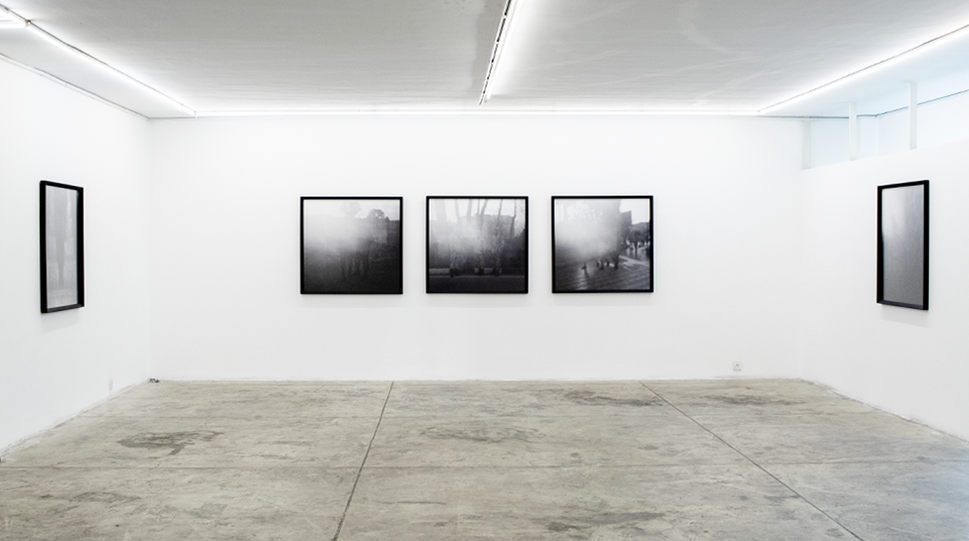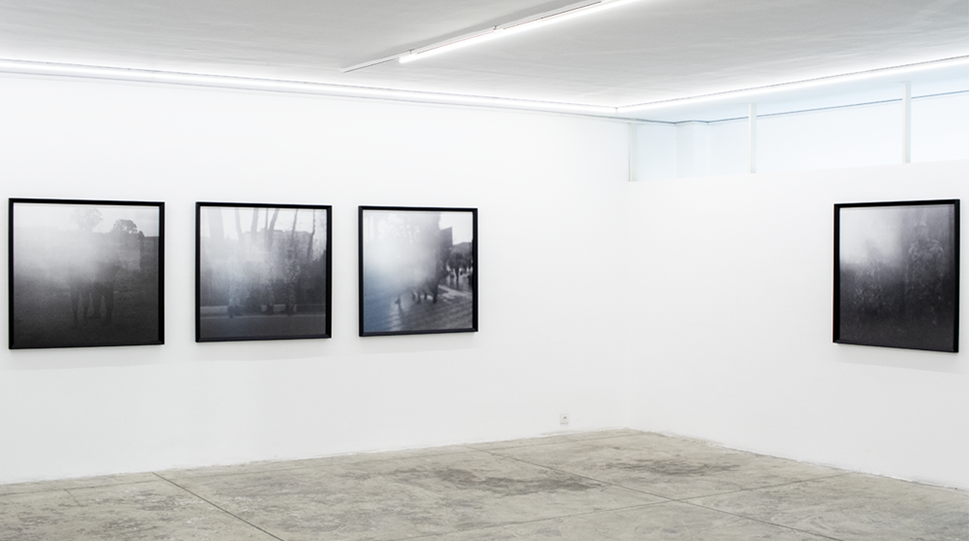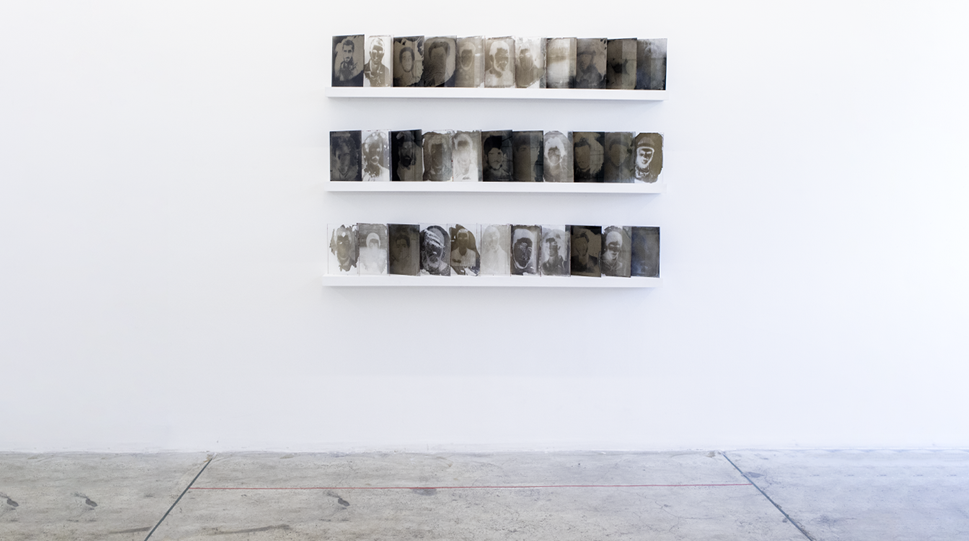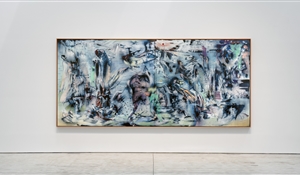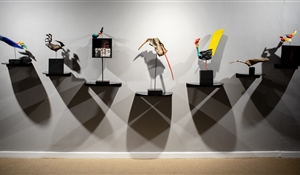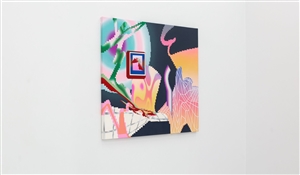Reading an Exhibition by Maryam Takhtkeshian
07 Dec 2021Original text in Farsi by Roozbeh Maleki
Translated to English by Omid Armat

Maryam Takhtkeshian | Untitled | 2020 | analog Photograph
An exhibition of photography and video by Maryam Takhtkeshian was hosted by Silk Road Art Gallery from September 25 to October 23, 2020. In an overall look, there are four categories of artworks in the show: huge, vague, black and white photographs that make up the major part of the show; images, presumably photographs of martyrs, re-photographed by Takhtkeshian with the wet collodion process; an excessively enlarged image of one of the pages of a birth certificate containing names of wife and children and almost completely filled with the word "martyr"; and finally, a video of Iraq war against Iran, which is created with archive videos.
It may be useful to focus on the main images of the show first, which are the huge, vague photographs, and then try to find out about the relation of this category with the other three. It has been mentioned in the exhibition's statement that "[images of] this series (that is the huge, vague photographs) are photographed with Agfa Isolette I"; a camera that its initial version was manufactured during the second world war and it was also known as "Soldiers' Camera". It is also said in the statement that the original photographs of this series are recorded on expired black and white negative films. Regarding the photographs and their content, it seems to be a wise decision to use an old camera and an expired film. This has resulted in vague images which not only make implicit readings possible through concealing the characters' identities and even the location of the photographs, but also help them being placed in juxtaposition to the photographs of martyrs. However, mentioning facts such as the camera's model or the practice of using a camera similar to those used during the second world war, lacks the necessary artistic expression. In fact, regarding the camera as a soldier's camera is really different from regarding it as a pinhole camera. Paying attention to the "Soldiers' Camera", which is a trademark, is not the same as precise consideration of the representation tool. In other words, using an old camera and an expired film, produces an aesthetic code which associates with the concept of the series, while mentioning the camera's model or the time when it was used in the history, remains as simple references and at best, may just seem interesting.
It is worth noting that when engaging with the huge blurred photographs in the Exhibition of Photography and Video, the viewer cannot perceive more information by getting closer to the photographs. Looking at the images closely to get more details, one cannot see anything but dark and bright bulks, thus making it impossible to acquire information about the soldiers and their surroundings. On the contrary, by distancing themselves from the photographs, the viewers can see them better, which also helps the viewers to be able to focus on multiple photographs at the same time; this makes the soldiers seem like a mass of uniform, anonymous characters. However, from a close distance, a narrow red line is visible on the edge of the frames; the line, as we will see, conveys its meaning in the second room and in relation to death. Regarding the expressive quality of these red lines, it would have been better to include the lines in the virtual format of works and especially on the gallery's website.

Maryam Takhtkeshian | Installation view at Silk Road Art Gallery
In order to understand the relation between this category with the other three, one should pay attention to their installation in the gallery. There is a photo installed right at the exhibition entrance, in which the presence of the photographer is discernable if the photograph is looked at from a close distance. On the right side of the exhibition space, there are images of soldiers, photographed individually and all together, in different locations throughout the city, such as parks, Azadi tower, etc.; these are places in which it is not unexpected to see soldiers. In the room on the left side, there are a few vague images of soldiers lying on the ground. The juxtaposition of these images and other photographs of martyrs and the birth certificate leads the viewer to a different reading; instead of resting in those familiar places, it is now explicitly indicating the soldier's death. So the meaning of those red lines along the edges of the frames on the right side becomes clear.
Positive and negative photographs of martyrs which, because of their installation, seem to be standing in a line, make up another important part of this show. These photographs which are actually glass plates of wet collodion, present often damaged images reminding of pale-colored, framed photographs of martyrs put on their gravestones. The red edges of these unframed images along with the sharp edges of glass plates remind the viewer of their relation to death or, to be more accurate, being killed. Eventually, the enlarged image of the birth certificate filled up with the word "martyr" makes the meaning of the photographs in this room clearly understandable.
According to the installation, the contrast between these two rooms may be much similar to the contrast between the soldier's situation during peace and war (life and death). While photographs in the room on the right side remind us of soldiers' souvenir photos, in the room on the left side photographs present a conflict which is resolved: soldiers lying on the ground, buried, and an expired birth certificate.
There is also a third room; a dark room in the middle in which archive videos of the Iraq war against Iran are displayed for about 5 minutes. Some parts of the video are visually similar to the vague photographs of soldiers installed in the room on the right side; images which show soldiers individually or altogether while resting, on an excursion, or even playing. Other parts of the video seem to show hours before carrying out an operation, which we know that it will lead to the photographs of the second room in a few hours. What probably attracts the viewer's attention is the soldiers' occasional laughter. These smiles may relate more than any other image to the birth certificate; the page about wife and children which may represent the wishes of young soldiers. The video ends in a red screen which is similar to the red edges of photo frames, and clearly indicates the soldier's death.
In conclusion, the experience of visiting and engaging with Maryam Takhtkeshian's series of photographs and videos cannot be simply replaced by watching photos of it. This is not only because of the huge prints, but also due to the details of the presentation, such as the red edges along the frames, the juxtaposition of photographs in the second room, the relation between the two rooms, and of course, good management of the gallery's large space.
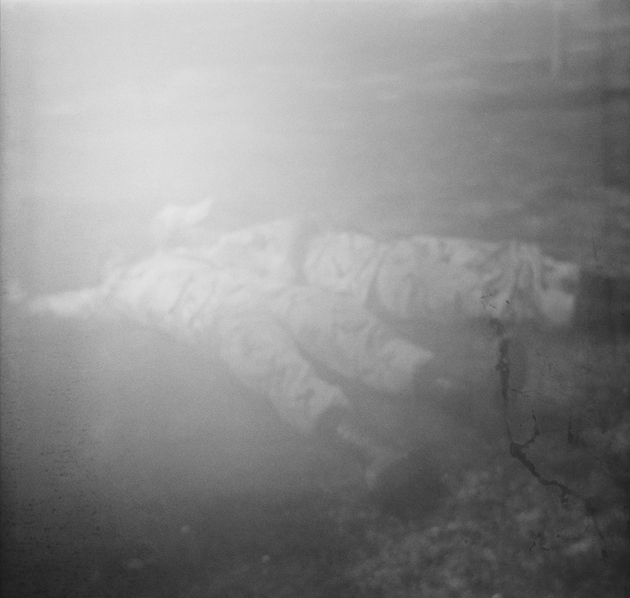
Maryam Takhtkeshian | Untitled | 2020 | analog Photograph




